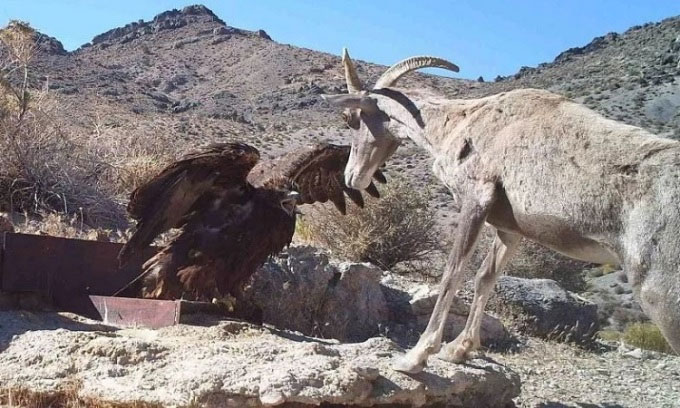Images from cameras in the Mojave Desert show a golden eagle possibly attempting to defend its territory against an encroaching bighorn sheep.

A golden eagle spreads its wings to block the approaching bighorn sheep. (Photo: USFWS)
One of the motion-sensor cameras from the U.S. Fish and Wildlife Service (USFWS) captured this image in the Desert National Wildlife Refuge in Nevada, as reported by Newsweek on July 27. In the photo, the golden eagle spreads its wings and opens its beak wide in front of a man-made water source, while the bighorn sheep stares at it.
This is a rare occasion where desert bighorn sheep face a predator. The golden eagle typically swoops down to hunt young bighorn sheep. However, in this interaction, the roles may be reversed. The behavior of the golden eagle could be defensive, as they are known for being territorial. Here, the eagle’s posture resembles that of confronting another eagle that is intruding on its territory.
Although the golden eagle population is currently not threatened, intentionally harming them or their nests and eggs is illegal under the Bald and Golden Eagle Protection Act. It is estimated that over 70% of golden eagle deaths are caused by human activities.
Bighorn sheep inhabit mountain ranges across the deserts of the United States. According to the National Park Service, they are well adapted to desert life, capable of withstanding body temperature fluctuations of several degrees, unlike most mammals. They can go without water for weeks or even months. The desert bighorn sheep subspecies is considered sensitive to the risk of extinction, primarily due to human activities such as hunting or competition with livestock. In the 1960s, the desert bighorn sheep population declined from tens of thousands to just 6,700 – 8,100 individuals.
The Desert National Wildlife Refuge serves as the largest intact habitat for bighorn sheep in the Mojave Desert, according to the USFWS. Trail cameras can help reveal many unique interactions and behaviors that have never been seen before in nature, as animals trigger the cameras through movement.


















































